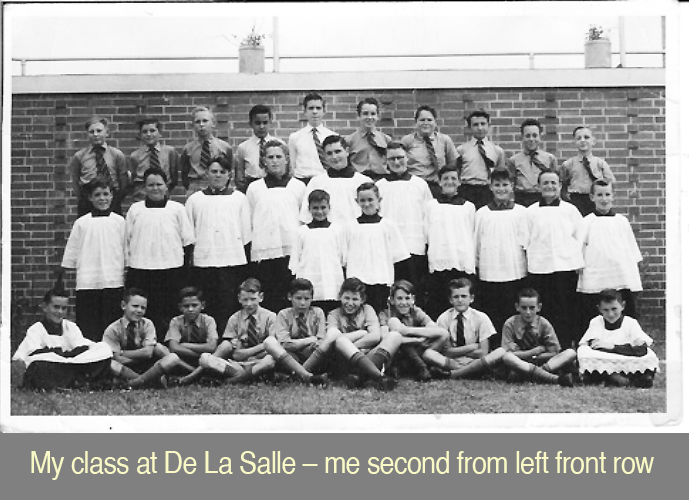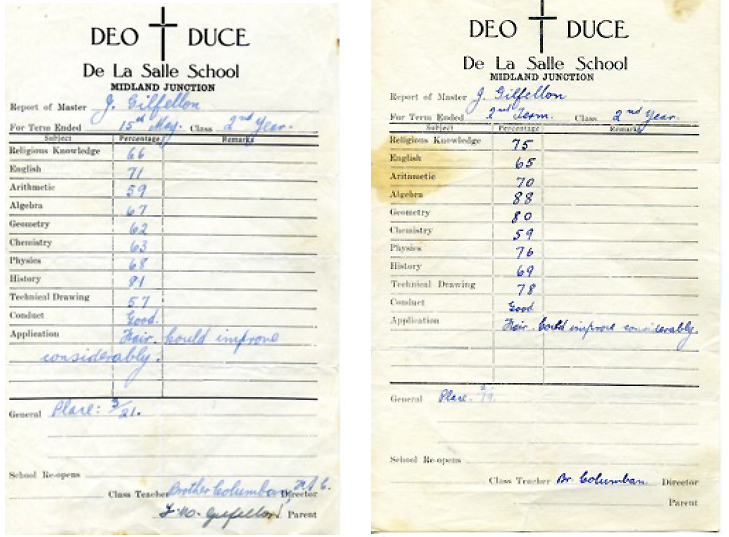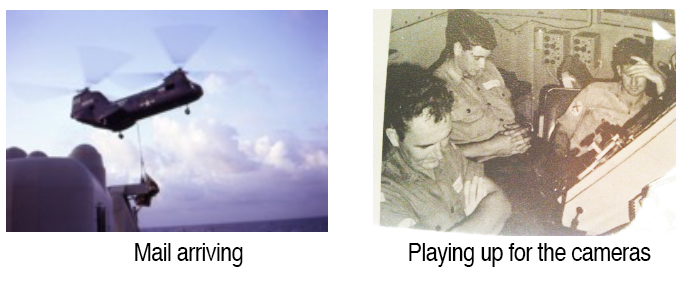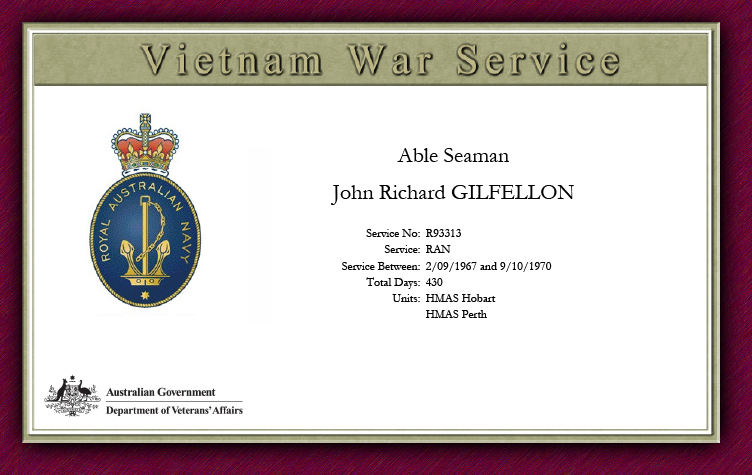De La Salle
I attended De La Salle College in the years 1958, 59 and 60. It was boys only then. I scrapped through my Junior in 1960 and left school. I took a job in Perth with J W Bateman delivering invoices around Perth on a push bike. This lasted until July 1961 when I joined the Royal Australian Navy for a 12 year period through the Junior Recruit Program. The program accepted boys between the ages of 15 and a half to 16 and a half. There were 150 boys in my intake.
Attending school from Mundaring meant a bus ride to and from school. Some afternoons with Alex Dunning we would try and hitch hike a ride to Mundaring. Alex lived in Sawyers Valley east of Mundaring. If not successful we would wait at the nearest bus stop for the bus.
My teachers were now all Brothers, and they were strict. In would mean the cane if you shrugged your shoulders when asked a question. Again I managed to get through the three years with only one “six of best”. That was for throwing something out of the second storey window.
One year (probably 59 or 60) there was heavy rain and the road to the school was flooded. The Brothers found a boat from somewhere and rowed us across the flood so that we could attend school.
There were no special facilities at the school like labs, etc so the subjects we did were very basic. Maths A & B, English, History, Chemistry, Physics and Technical Drawing.

As the reports below say I did have trouble applying myself at school, however finishing second out of nineteen was not too bad as number one was John Capaletti who was just a brain with legs. I did achieve the second best aggregate in my junior year (year 10) once again behind you know who. My prize was a book “The Overland Telegraph” which I have still got. It was inscribed by Mum.

HMAS Perth
On 5th September 1966 I arrived on the HMAS Perth. As the ship had been built in America most of the crew had gone over to collect it so I had to listen to all their stories.
In April 1967 while on a visit to Hobart the Perth was sent to Macquarie Is to bring back a seriously ill researcher from the Australian base there. Macquarie Is is an Australian territory situated 1,500 kilometres south east of Tasmania (about half way to Antarctica). The weather was very rough going and coming with the ship rolling near 45 degrees at times. Most of the trip the outside decks were closed because the sea was continually breaking over them putting lives at risk. On arrival the sea was too rough to send in the boats so the clearance divers had to swim lines inshore to achieve the rescue. One of the divers dressed in his black wet suit and greased up against the cold water was sure that a bull seal was making eyes at him.
While at sea when no exercises were being held the crew were allowed a beer issue. Each crew member was entitled to one large can of beer, same size as a bottle. Some crew members would ask others to order theirs so that they would have more than one. The cans were opened on collection so by the time they drank two or three the last one was almost flat. I did not usually take up my issue.

On 2nd September 1967 we sailed for the Perth’s first seven month tour of duty in the Vietnam War. On the way north we had to cross the equator and as with navy ships we had a crossing of the line ceremony. Those deemed to be crossing the line for the first time, or for any other reasons were gathered up by the fuzz, the largest blokes among the crew and brought for sentencing by Neptune, nobody was exempt.
After sentencing, nobody got off by the way, you were then dunked in a pool full of a mixture of foul stuff. It helped moral and provided some entertainment.
We joined the American Seventh Fleet on 14th September 1967. We were stationed at Subic Bay, a large American naval and air force base in the Phillipines. I remember a sense of excitement as we arrived with over 50 naval ships of all descriptions tied up and anchored and air force planes taking off regularly from the base across the bay. The Perth tied up three ships deep at the wharf. The American destroyer we tied up to was undergoing repairs from being hit by enemy gunfire. There was movement everywhere with ships being refuelled, taking on more ammunition and stores, you got the sense that you were in the war zone although a long way from Vietnam. Announcements being made of numerous ships speakers reinforced the excitement.
“All those that have done wrong muster at the sheriff’s office”, “Gedung alongside” (this was a food van that drove up and down the wharf selling all sorts of edibles) were just some of the memorable announcements. The navy base had a supermarket, large canteen and bar, ten pin bowling alleys and other sporting facilities. There were around 20,000 sailors at the base so they had to be supplied.
Olongapo, a town outside the gates of the base was where we went on nightly shore leave. It was basically a long street of bars. We were told not to venture from the main street as it was extremely dangerous. I was unlucky enough to get “Shore Patrol” duties on some of the nights I had to work. I got to go with the American shore patrol to break up any fights that included Australians. The Americans did not like getting involved with Australians. We worked out of the local police station, the police treatment of the locals was extremely harsh.
The Americans reaction reminded me of the time in Sydney hotel when an American sailor approached us and offered to buy us a drink. He said that his father, who had been to Australia during the second world war, had advised him “that if you meet any Australians, buy them a drink, don’t try to fight them”. We spent the next hours talking Australian for them with phrases such as, “gooday mate” “cooey cobba”, and “stone the crows”
Our role included firing at enemy positions in support of American troop positions and enemy supply routes over two thirds of the North Vietnam coast. In harassing enemy supply routes and boats off the coast we came under heavy enemy fire on a number of occasions. On 18th October 1967 the Perth was hit by enemy gunfire while shelling North Vietnamese coastal batteries just north of the North/South border.
 While on station we operated in four hour shifts, during the day while not on shift we would still carry out our normal duties. We normally sailed a good way off the coast but when we got a call to carry out shelling we would head closer to the coast to be in range. The day we were hit I was on morning watch (3.50am to 7.50am) (navy tradition is that the watch changes 10mins before the hour so as not to interrupt the things that have to happen on the hour) I got my breakfast and was sitting with a few mates when we heard a sound like large hail stones hitting the ship, I jokingly said that it sounds like we were under fire when the alarms went off and we were instructed to get to our stations as we were under fire.
While on station we operated in four hour shifts, during the day while not on shift we would still carry out our normal duties. We normally sailed a good way off the coast but when we got a call to carry out shelling we would head closer to the coast to be in range. The day we were hit I was on morning watch (3.50am to 7.50am) (navy tradition is that the watch changes 10mins before the hour so as not to interrupt the things that have to happen on the hour) I got my breakfast and was sitting with a few mates when we heard a sound like large hail stones hitting the ship, I jokingly said that it sounds like we were under fire when the alarms went off and we were instructed to get to our stations as we were under fire.
My station, when not on watch directly below the mess in the centre of the ship, was in our sleeping quarters at the rear of the ship. I scrapped my plate in the bins and placed the plate in the scullery (where the washing up was done) and open the door to go to my station when an enemy shell exploded in the passageway about twenty metres away. Luckily the shell exploded in a room with a door similar to that of a safe, the strength of the door contained most of the damage to the room. If the shell had not exploded in the room damage could have been extensive, as it was the door was blown off its hinges. One sailor heading toward me was blown off his feet and I felt the force of the explosion. I shut the door only to have to open it when an officer ran to the explosion and closed it after him. I then went down to my station with the sounds of the explosions in the water and shrapnel hitting the ship still continuing. It is estimated that over 200 shells were fired from shore that morning, most directed at the Perth.
The shell that hit the Perth came through the roof of our aft gun turret. The Leading Hand in charge of the turret got his crew into position and started to return fire. As we were heading away from shore the forward gun was no help. The Captain directed the ship toward the most recent salvo the landed in the water. Our accompanying American cruiser the USS Newport News had already steamed out of range.
Four sailors were injured of which two were evacuated to the American cruiser later in the day were they could be taken to a hospital ship by helicopter as helicopters could not land on the Perth. Winching the injured up to a helicopter was not considered an option.

For our periods of rest and recreation we visited Bangkok and Hong Kong for Christmas. While in Hong Kong myself and two others were hosted by a family for Christmas dinner. The husband worked for the Australian Egg Board and they lived in a high rise building. He drove us around Hong Kong in the afternoon and showed us the sites. During dinner we were asked if we would like a drink, only to be told that they had no alcohol as they did not drink, this was a disappointment but we got over it. As families were required to hire a local maid it was a novelty to be served by a maid and the meal was great.
On one other occasion when we came under fire I was off watch and playing cards at a table in our sleeping quarters when the announcement came that the ship was under fire. We sat at the table listening to the explosions as the shells hit the water, we forgot about the cards for a while and just waited to see if any of the shells hit the ship and where. When the all clear was given we looked at each other in relief and comments were passed such as “boy you certainly turned white”. All this was bravado of course as we were all just as frightened as each other.
Organisation made up packages for the troops in Vietnam and one night my Auntie Edie (she was in Darwin during the bombing in WW2) heard that all troops serving in Vietnam were receiving regular packages, she was aware that we on the Perth were not so she was straight on the phone to the station. We began receiving packages soon after.
The only way to communicate with home was by mail. So I would write a letter then wait weeks for a reply. No email or facebook then. Mum would send me packages of homemade cakes and biscuits which were really appreciated.
Our families had the opportunity to send a visual message as the Navy arranged for the families to go to Leeuwin and be filmed. The movies were shown in the mess (the large dining room). I got to see my family and hear their best wishes. My Dad being an Army man finished of his wishes by saying “keep your head down” which was applicable in the Army but meant sleep in the Navy. I got a bit of teasing over that. It was great to see them and know that they were thinking of me.
The Perth was referred to as the Grey Ghost during the deployment and after each replenishment at sea after the last lines were let loose that attached us to the replenishment ship we would steam away for the ship at speed and the tune “Ghost riders of the sky” was played loudly over the intercom so we and the replenishment ship could hear it. There was always a buzz of excitement as we steamed away with the tune playing.

HMAS Hobart
I was transferred to HMAS Hobart arriving on 30th June 1969 after a couple of weeks leave at home.
In August 1969 while exercising off Sydney the Hobart was sent to search for survivors of the merchant ship SS Noongah that had capsized and sunk in rough seas. We found one of the crew who although dead was kept afloat by his life jacket. It was not a pretty sight as we bought him onboard as the sea birds had been pecking at his shoulders and face. His body was kept in the freezers until we docked in Sydney.
On 16th March 1970 we sailed for a seven month deployment with the US Seventh Fleet in Vietnam. Bombing of North Vietnam had been halted so we were stationed of the coast of South Vietnam providing support for ground forces by shelling enemy positions identified by spotter planes or ground troops.
As with my deployment on the Perth we would spend about 35 days on station being replenished with fuel, food and shells from American supply vessels. Regular mail deliveries were received by helicopter. On a previous deployment in June 1968 the Hobart had been hit by missiles fired by an American war plane and two sailors were killed. One of the missiles had entered the mess where I later slept but did not explode. When I lay in my bunk I could see the patch that had been welded over the hole made by the missile.

After a couple of tours off the coast of Vietnam we would receive some R & R (rest and recreation) at another port. Our visits were to Cebu in the Phillipines, Singapore and Hong Kong. We arrived back in Sydney on 17th October 1970.
In February 1971 we undertook a training cruise to New Zealand visiting the Bay of Islands and Auckland. A workup period followed in June and July to ready the ship for our next tour of Vietnam. In August 1971 the Prime Minister announced the withdrawal of Australian support in Vietnam and we were told that we would not be relieving the HMAS Brisbane. To help us get over our disappointment in October 1971 we sailed for Pearl Harbour in Hawaii to participate in exercises with the American navy. On route to Hawaii the ship stopped at Suva the capital of Fiji for a couple of days. We returned to Sydney on 10th December 1971.


